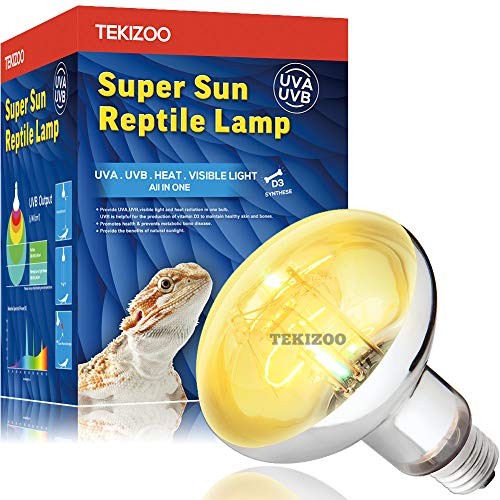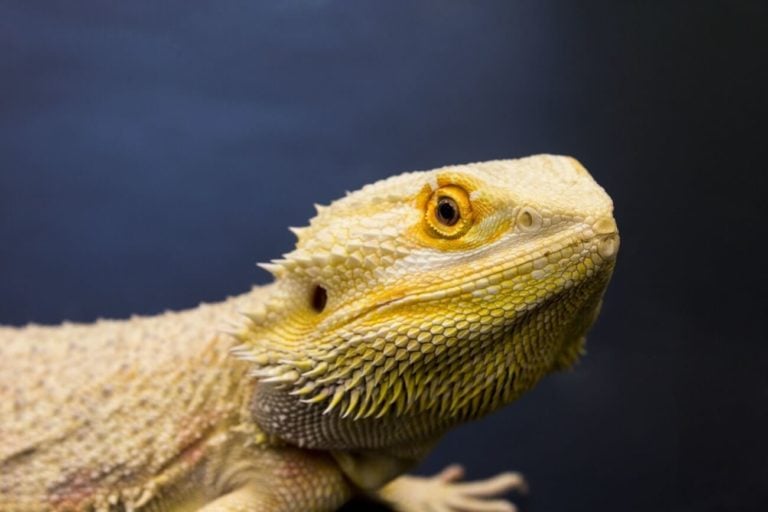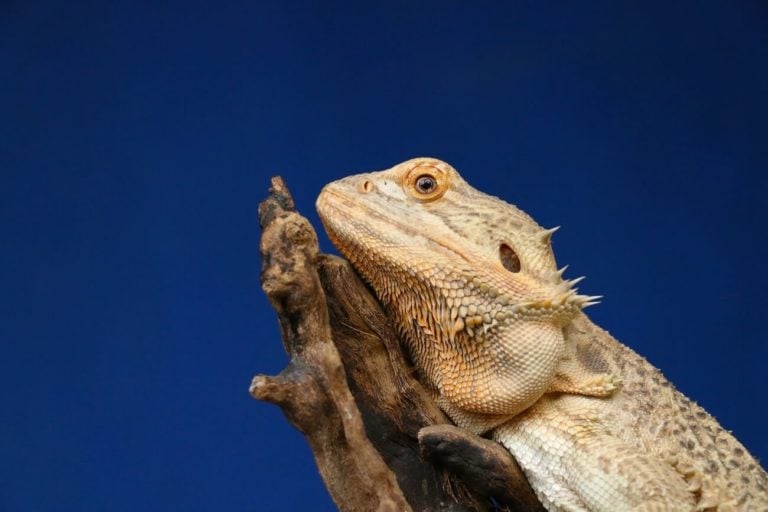Bearded dragon impaction is something that many owners are afraid of.
And for good reason.
If left untreated, impaction can lead to a long list of serious health complications for your beardie. In some cases, it can even be fatal.
But the chance of this happening to your beardie is very low if you know what to do. As always, being a knowledgable and prepared owner goes quite a long way.
In this guide, we’ll cover the causes, signs, and treatment options for impaction in bearded dragons. By the time you’re done reading this, you’ll see that there’s nothing to fear!
Table of Contents
What Is Impaction?
When a bearded dragon is suffering from impaction it means the digestive tract is being blocked by a hard mass. This is an extremely serious issue that can be potentially fatal (even in an ordinarily healthy beardie).
The reason it’s so serious is that this blockage can cause your bearded dragon to not be able to fully move its bowels. Reptiles in captivity don’t do well when their digestive system grinds to a halt, so it’s a problem you need to sort out immediately.
What Are The Common Causes Of Impaction?
There are a number of possible reasons for bearded dragon impaction, but a few occur far more than others. Knowing what they are is essential as an owner so you can minimize the risk of them happening to your pet.
1. Unsafe Substrate
An unsafe substrate is one of the most common causes of impaction in bearded dragons (this is why it’s one of the most important parts of a proper habitat setup). Loose substrate such as sand or pellets and commercial products like Calci-Sand can lead to severe blockage if ingested over a period of time.
Expert Tip: Many substrate manufacturers claim their products are 100% safe. However, because reptile products are virtually unregulated, companies that make false claims typically go unpunished.
Bearded dragons are notorious for consuming anything they get into, which means it’s best to use a safe solid substrate. Materials like paper towel, newspaper, reptile carpet, excavator clay, ceramic tile, and rubber shelf liner are all good options. In addition to their safe qualities, these solid materials are much easier to clean than are loose substrate!
2. Incorrect Habitat Temperature
In order to properly digest its food, the cold-blooded bearded dragon can’t produce its own body heat and needs a warm place in which to bask (this is one of the reasons why a UVB bulb is so important).
- Provides strong and consistent UVB and UVA for reptiles
- Bulb is compatible with a variety of enclosures
- Compact size of 6.3 x 4.5 inches
- Bulb undergoes strict testing before being packaged
Ideally, you should keep the basking area temperature between 95 and 115 degrees Fahrenheit. If your bearded dragon is a baby they’ll need the temperature to be in the 105 to 110-degree range.
Make sure your dragon has access to his basking area for at least an hour after feeding, and always feed him at least one hour before you turn off his lights at bedtime. This will help stimulate digestion and keep their system working properly!
3. Improper Diet
Any food that’s too large to move through a bearded dragon’s digestive tract can block whatever food they consume later, leading to impaction. As a general rule, only offer your beardie food that’s smaller than the distance between their eyes.
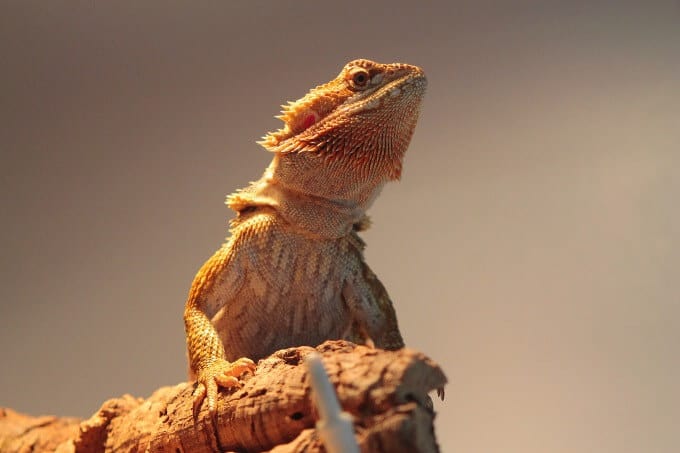
The type of food also matters, so pick their diet carefully.
Large crickets, superworms, and mealworms have exoskeletons that are can be hard for your dragon to digest. Never give a baby dragon these foods, and only feed them occasionally to an adult. Dubia roaches are a much better alternative.
Expert Tip: Lastly, when a bearded dragon is outside their enclosure, they might try to consume random objects that fit into their mouth. You never know what they’ll get into, so watch them carefully while they’re out exploring!
Signs And Symptoms Of Impaction
The two general signs of impaction are a mix of physical, which are easily recognizable, and behavioral, which are more subtle and difficult to detect.
Identifying them is a much easier process if you’re familiar with a bearded dragon’s usual habits and give them a quick inspection each day (without being intrusive). This will allow you to notice anything out of the ordinary.
The first sign, of course, is when your beardie stops moving their bowels and fails to poop. Baby dragons usually have a bowel movement every day (depending on their activity level), and adults can actually go for a week or longer without going to the bathroom.
Because you’re the owner, it’s your responsibility to be aware of your beardie’s regular habits and when they deviate from the normal pattern.
If you suspect impaction, watch your pet’s movement as they walk.
If the gait is awkward and stiff or if at least one of the rear legs drags or is shaky or immobile, there may be a serious impaction issue. If the impaction is higher up in the digestive tract or if an impaction located farther down has considerably grown, the front legs may also become paralyzed.
Expert Tip: Paralysis (either in the front or back legs) can be caused by impaction because your bearded dragon’s stomach and intestines run close to the spine. This exerts pressure on the spine, and unlike many other vertebrates, reptiles lack discs between their vertebrae to protect it.
This means if you notice a bump on your dragon’s back between the vertebrae, or a bulging or tender belly, your beardie may be suffering from impaction.
Other signs of impaction include weight loss and a generally unhealthy appearance. This is why it’s important to know your bearded dragon well so you can identify odd behavior.
A loss of appetite, regurgitation, or complete rejection of food isn’t normal (nor is straining when they’re trying to defecate). If your pet is lethargic or totally inactive, there’s definitely cause to be concerned.
Impaction Treatment Options
If there have been a couple of days with missed bowel movements and you suspect your bearded dragon may be suffering from impaction, there are a few home remedies you can try (assuming the symptoms aren’t too severe). Obviously, if things are looking serious it’s always a good move to take your beardie to the vet.
Here are some of your options:
1. Check The Temperature Of The Basking Area
Because a cool basking area is detrimental to your bearded dragon’s digestive health (and basking bulbs lose strength over time), you should regularly check the basking zone temperature.
Although a thermometer gives you a general idea of the temperature, an inexpensive temp gun is even more accurate. A difference of just a few degrees can significantly affect your reptile’s digestive health.
2. Give Your Beardie A Warm Bath
Many bearded dragons prefer to defecate in water, so try putting yours in a warm bath to stimulate their system!
Use your handy temp gun or thermometer to make sure the water is about 100 degrees Fahrenheit. Fill the bath a bit deeper than usual to allow your reptile to swim around comfortably.
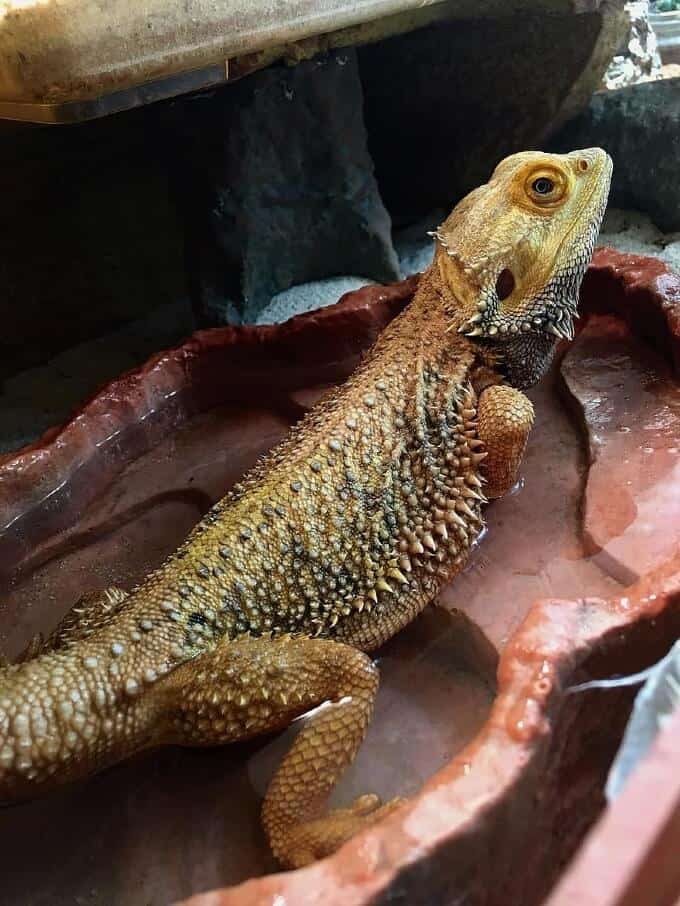
About 20 to 30 minutes should be ample time for your beardie to relax and do their duty. Remember to occasionally add warm water throughout the duration of the bath to keep it from becoming too cold.
Expert Tip: Even if your bearded dragon is healthy, it’s a good idea to treat them to a weekly bath. They’ll not only enjoy the experience, but it can help prevent future impactions!
3. Give Them A Massage
While it’s in the bath, you can try two types of massages to try and help your bearded dragon through impaction.
The first, which is a bit gentler, involves your carefully stroking its side from head to tail. This hopefully will move things along the digestive tract.
Expert Tip: Remember to always work gently, as the impaction could potentially be pressing on the internal organs or spine.
The second massage, exerting a bit more pressure than you did with the previous massage, will be on the abdomen. Press downward gently on the chest. Repeating this process can result in a successful passing of an amazing amount of feces, especially after they’ve been impacted for a long period of time. Don’t force it though!
Whichever type of massage you use, always keep your pet standing upright and supported with your hand. Never leave them on their back, as bearded dragons have great difficulty breathing on their backs.
4. Try Some New Food
It’s very important to avoid feeding your impacted dragon the live animals that might be included in their normal diet. Instead, provide them with soft and easily digestible foods that are easier on their system.
This includes:
- Warmed baby foods (pureed pumpkin, apple, prunes, or even watermelon are great)
- Canned pumpkin diluted with water
- 100-percent fruit juices that are sugar-free
An impacted dragon may hesitate to eat at first. If you’re having trouble persuading them to eat this new food, place a little puree on their nose. They will likely lick it off instinctively, even if they didn’t actually intend to eat it! You can also use a syringe to squirt a bit of puree on their nose or even in their mouth.
Expert Tip: Another trick is to place a couple drops of olive oil on their nose, which they’ll hopefully lick off. This can act as a laxative and help clear things up (only use olive oil, no other types of vegetable oil).
5. Take Your Bearded Dragon To The Vet
If none of the home treatments work within a week or so or if the symptoms are serious (such as immobility, regurgitation, or leg dragging), immediately take your beardie to the vet.
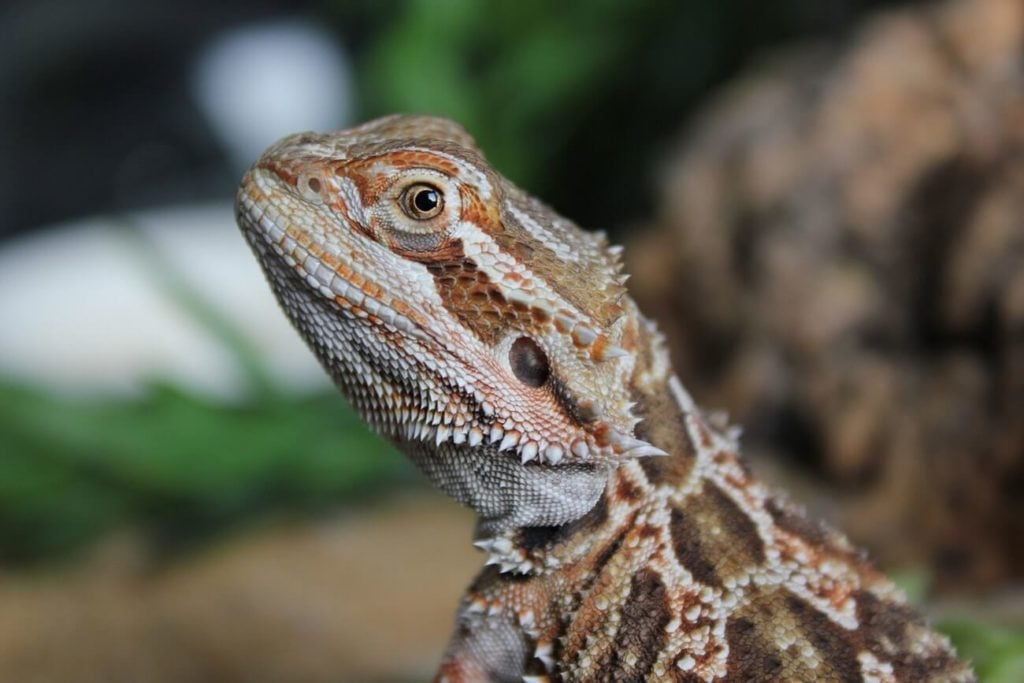
Your vet should preferably be one who specializes in exotic animal medicine. He or she will first X-ray the abdominal area to determine the severity of the impaction. The vet will then work with you to come up with a clear treatment plan (this usually involves laxatives of some sort).
If that doesn’t produce results, he or she might try an enema.
If neither laxatives nor an enema clears the impaction, surgery may be necessary. Although you might consider surgery an expensive alternative, remember your pet’s life is at stake. Many veterinarians offer payment plans that can significantly ease the financial burden for pet owners.
Is There A Difference Between Impaction And Constipation?
Although both impaction and constipation can display similar symptoms, there is technically a difference between the two conditions. A common issue among many animal species, constipation occurs when the animal is having difficulty digesting its food, resulting in the inability to defecate.
In bearded dragons, there can be several reasons for constipation (such as dehydration or a basking spot that’s too cool) which can result in digestive difficulties.
Impaction, which can be far more serious, results from an indigestible mass that accumulates in the animal’s gastrointestinal tract. The mass hardens, grows over time, and becomes progressively more uncomfortable.
The blockage could be anything. Either organic (such as bark, substrate, or insect exoskeletons) or inorganic (such as rock or sand).
Conclusion
While having an impacted bearded dragon is obviously not ideal, there are plenty of ways you can help them. As you can see, there’s really nothing to be afraid of when it comes to this condition!
We hope this guide has helped make you a more prepared and confident owner. The more you know, the happier your pet will be.
If you have any questions that we didn’t answer in this guide we’re more than happy to help you directly. Just send over a message and we’ll get back to you as soon as we can.

